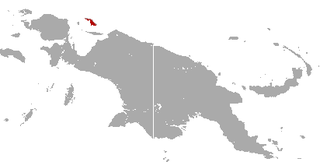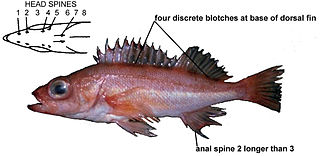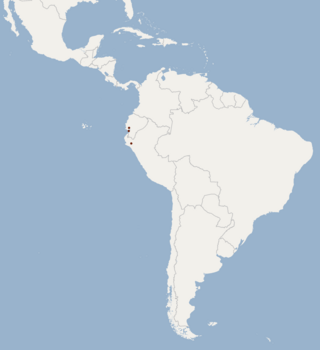
Honduras, officially the Republic of Honduras, is a country in Central America. Honduras is bordered to the west by Guatemala, to the southwest by El Salvador, to the southeast by Nicaragua, to the south by the Pacific Ocean at the Gulf of Fonseca, and to the north by the Gulf of Honduras, a large inlet of the Caribbean Sea. Its capital and largest city is Tegucigalpa.

Cerrophidion is a genus of venomous pitvipers which are endemic to southern Mexico, Central America, and western Panama. The generic name, Cerrophidion, is derived from the Spanish word cerro, which means "mountain", and the Greek word ophidion, which means "small snake". Five species are recognized as being valid, but no subspecies are.
Wilson's indigobird or the pale-winged indigobird, is a species of bird in the family Viduidae. It is found in Cameroon, Central African Republic, Chad, Republic of the Congo, Democratic Republic of the Congo, Ivory Coast, Ghana, Guinea, Guinea-Bissau, Nigeria, Senegal, South Sudan, and Togo.

Epixerus ebii, also known as Ebian's palm squirrel, Temminck's giant squirrel, or the western palm squirrel, is a species of rodent in the family Sciuridae. It is the only species in the genus Epixerus, although eastern populations were previously regarded as a separate species, E. wilsoni. It is found in West and Central Africa. Its natural habitat is subtropical or tropical moist lowland forests. It is threatened by habitat loss.

Cerrophidion godmani is a venomous pit viper species native to southern Mexico and Guatemala. No subspecies are recognized as being valid. It is also known commonly as Godman's montane pit viper or Godman's pit viper.

Cerrophidion tzotzilorum is a venomous pit viper species which is native to southern Mexico. There are no subspecies that are recognized as being valid.

Borealosuchus is an extinct genus of crocodyliforms that lived from the Late Cretaceous to the Eocene in North America. It was named by Christopher Brochu in 1997 for several species that had been assigned to Leidyosuchus. The species assigned to it are: B. sternbergii, the type species, from the Maastrichtian of Colorado, Montana, North Dakota, South Dakota, and Wyoming; B. acutidentatus, from the Paleocene of Saskatchewan; B. formidabilis, from the Paleocene of North Dakota; B. griffithi, from the Paleocene of Alberta; and B. wilsoni, from the Eocene of Wyoming. B. formidabilis is particularly well-known, represented by the remains of many individuals from the Wannagan Creek site in North Dakota. An indeterminate species is known from the Late Cretaceous Demopolis Chalk in Alabama.

Carolinochelys is an extinct genus of sea turtle from Oligocene of United States. It contains one species: C. wilsoni, and was first named by O.P. Hay in 1923.

The blue-eyed spotted cuscus or Biak spotted cuscus is a species of critically endangered marsupial in the family Phalangeridae.

The pygmy rockfish, also known as the slender rockfish or Wilson's rockfish, is a species of marine ray-finned fish belonging to the subfamily Sebastinae, the rockfishes, part of the family Scorpaenidae. It is found in the eastern Pacific Ocean.

The Iranian worm snake is a species of snake in the family Typhlopidae. The species is endemic to Iran.
Papilio wilsoni is a butterfly in the family Papilionidae. It is found in Ethiopia.

Eumops wilsoni is a species of bat native to Ecuador and Peru. The bat has a distinct karyotype, sequence of the mitochondrial cytochrome-b gene, and other distinct genetic markers that distinguish it from closely related bats such as Eumops glaucinus and Eumops ferox. However, there are no morphological distinctions from those related species and thus there is uncertainty of its geographic distribution and population status, leading to its classification as "data deficient". Local threats to the bat's dry forest habitat further impede efforts to study the bats. Transition to farmland and urbanization threatens the dry forest habitat of the bat in the Andes. As an endemic species, the bat may be threatened by this habitat loss.

Aporometra wilsoni is a marine invertebrate, a species of crinoid or feather star in the family Aporometridae. It is found in shallow water around the coasts of southern Australia.

Daspletosaurini is an extinct clade of tyrannosaurine dinosaurs that lived in Laramidia during the Late Cretaceous period. It consists of two genera: Daspletosaurus and Thanatotheristes. Four species have been described in the two genera, namely Daspletosaurus torosus, Daspletosaurus horneri, Daspletosaurus wilsoni, and Thanatotheristes degrootorum. At one point all of them were assigned as specimens of D. torosus, but several papers since 2017 have found them to represent distinct species. Some researchers found anagenesis in the group, whether contained in a daspletosaurin clade or paraphyletic in respect to the lineage of tyrannosaurines leading up to Tyrannosaurus, but a 2023 study refuted this theory on the basis of morphological and stratigraphical data.

Anolis wilsoni is a species of lizard in the family Dactyloidae. The species is found in Honduras.
Torrejonia is a genus of extinct plesiadapiform that belongs to the family Palaechthonidae. There are currently two species known, T. wilsoni and T. sirokyi. This genus is present in the fossil record from around 62–58 Ma. Species belonging to this genus are suggested to be plesiadapiforms based on adaptations observed in the skeletal morphology consistent with arboreal locomotor behavior. Following the mass extinction event at the Cretaceous–Paleogene boundary (K-Pg), a large diversity of plesiadapiform families were documented beginning at the Torrejonian NALMA. Research has shown that T. wilsoni is one of the largest palaechthonids and is reconstructed as being more frugivorous than other palaechthonids.
Oxybelis wilsoni, the Roatan vine snake, is a species of snake of the family Colubridae.
Cerrophidion sasai, the Costa Rica montane pitviper, is a venomous snake mostly found in the southeastern parts of Mexico to the west of Panama. In Costa Rica it is found in the Cordillera Central and Cordillera de Talamanca at altitudes from 1,460 to 2,875 m












